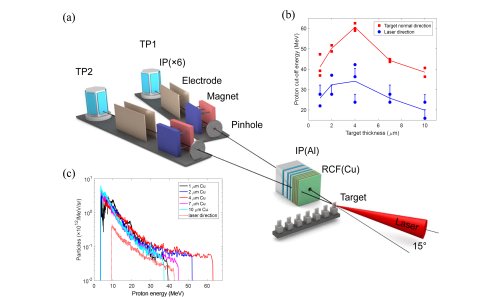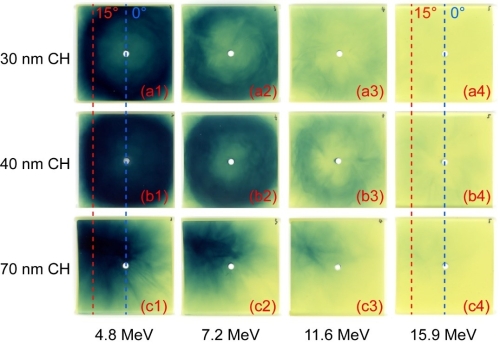A research group from Shanghai Institute of Optics and Fine Mechanics (SIOM) of the Chinese Academy of Sciences (CAS) reports the experimental results in the commissioning phase of the 10 PW laser beamline of Shanghai Superintense Ultrafast Laser Facility (SULF), achieving high-energy proton beams with energies up to 62.5 MeV by using SULF-10 PW beamline. This is among the state-of-art results in proton acceleration using femotosecend lasers, published in High Power Laser Science and Engineering on the cover on Jul. 18, 2022.
To date, several laser facilities aiming at 10 PW-level output power are built or under construction, such as ELI, Vulcan-10 PW, Apollon-10 PW, and SULF-10 PW. SULF-10 PW is the first 10 PW-class laser facility in China, which was proposed and constructed by SIOM in 2016 and realized output peak power up to 10.3 PW in 2018. These facilities can create unprecedented extreme physical conditions in the lab and strongly motivate the studies of laser-driven particle acceleration, x/gamma ray radiation, laboratory astrophysics, laser-driven nuclear physics etc. Laser-driven ion acceleration is attracting wide-spread interest because of the prospects of realizing compact and affordable ion sources for many exciting applications including cancer therapy and inertial confinement fusion.
The SIOM research group has built the first 10 PW laser-physics experimental platform of SULF in the world. The commissioning experiment of the SULF-10 PW beamline was focused on laser-proton acceleration using plain Cu targets. The laser energy of 72±9 J is directed to a focal spot of ~6 μm diameter (FWHM) within 30 fs pulse duration, yielding a peak power of 2.4 PW and intensity around 2.0×1021 W/cm2 on target. The experimental results shows that optimum thickness of targets for laser-proton acceleration is 4 μm, and the proton spectrum shows the broad-energy-spread distribution. Meanwhile, the measured electron temperature follows the ponderomotive scaling law. The features mentioned above suggest that target normal sheath acceleration (TNSA) regime is dominant given the provided laser intensity and micrometer-thick Cu foils. For 4-μm-thick foils, the average cut-off energy of protons is 60 MeV according to the data from 3 shots, where the highest one achieves 62.5 MeV.
Laser-driven proton acceleration using nanometer-thick plastic (CH) foils is also investigated. Clear ring-like profiles appear for l=30 nm and 40 nm on all RCF layers, indicating that protons are not effectively accelerated since ionization and pre-expanding of the nanometer-thick targets driven by pre-pulses may lead to relativistically transparent plasma. Filamented structure emerges when the target thickness increases to 70 nm, which is possibly associated with Weibel instability and is an obvious sign that the plasma is still opaque rather than transparent.
The first experimental results in the commissioning phase demonstrate the capabilities of the SULF-10 PW beamline, e.g., both ultrahigh intensity and relatively good beam contrast. Further optimization for these key parameters is underway, where peak laser intensities of 1022-1023 W/cm2 and better laser contrast are anticipated to support various research on extreme field physics and high energy density physics.
The operation team of SULF laser facility has given great support to the experiment.

Fig.1. (a) The sketch of the experimental setup. (b) The proton cut-off energy as a function of the target thickness of Cu-foil along the laser direction and the target normal direction. (c) Typical proton spectra for various target thicknesses. (Image by SIOM)

Fig.2. Proton beam profiles for plain CH targets with three different thicknesses. (Image by SIOM)
Article Website:
https://doi.org/10.1017/hpl.2022.17
Contact:
WU Xiufeng
General Administrative Office
Shanghai Institute of Optics and Fine Mechanics, CAS
Email: xfwu@siom.ac.cn
Web: http://english.siom.cas.cn/